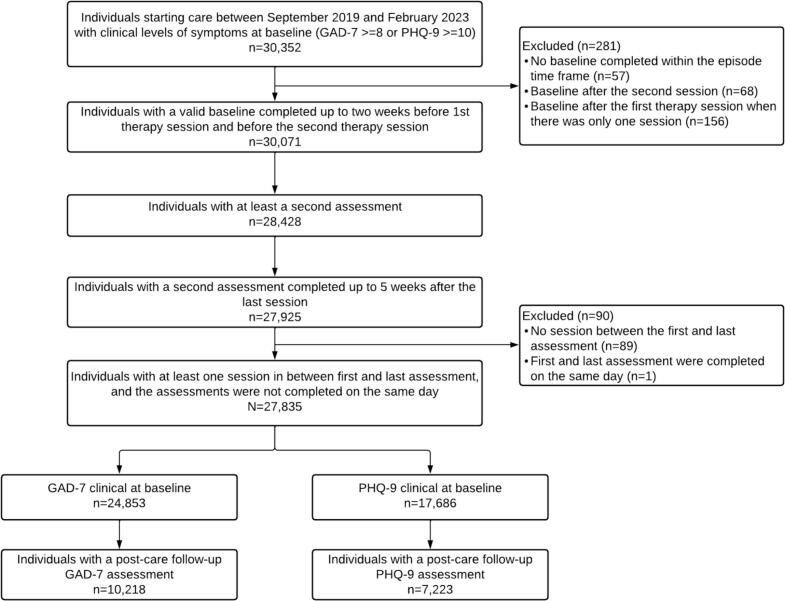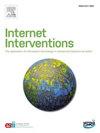Clinical outcomes from blended care therapy for anxiety and depression in the year after treatment
IF 4.1
2区 医学
Q1 HEALTH CARE SCIENCES & SERVICES
Internet Interventions-The Application of Information Technology in Mental and Behavioural Health
Pub Date : 2024-12-28
DOI:10.1016/j.invent.2024.100798
引用次数: 0
Abstract
Background
Scalable evidence-based treatments for anxiety and depression, such as blended care therapy (BCT) that integrate digital tools are effective, but reporting on long-term outcomes is limited.
Method
This pragmatic observational study examined the symptom stability and trajectories of individuals in the year following engagement in a BCT program. Participants included adults with clinical anxiety and/or depression measured by the Generalized Anxiety Disorder-7 (GAD-7) or Patient Health Questionnaire-9 (PHQ-9). Assessments were sent during the initial episode of care and in the year following.
Results
Participants included 27,835 adults (depression: 17,686 and anxiety: 24,853). Of these, 11,465 (41 % of those who received initial care; depression: 7223; anxiety: 10,218) completed at least one follow-up assessment (FUA). Average age was 34 years, 68–69 % were female, and 48–49 % were White across subsamples. Among FUA respondents, rates of reliable improvement or recovery on the PHQ-9 or GAD-7 for those who did not receive additional therapy were above 81 % across follow-up periods. Growth curve analysis for those who did not return for additional therapy revealed that both depression and anxiety groups demonstrated a statistically significant yet small linear effect of time in the year following treatment, with a 1.6–2.1 point increase in scores over the 12-month period.
Conclusions
Among clients who completed FUAs and received no additional therapy, reliable improvement and recovery rates were high. Growth curve analysis demonstrated a small increase in symptoms over the 12-month interval, providing pragmatic evidence of long-term stability of treatment gains from BCT for anxiety and depression in a real-world setting.

混合护理治疗焦虑和抑郁治疗后一年的临床结果。
背景:可扩展的基于证据的焦虑和抑郁治疗方法,如整合数字工具的混合护理疗法(BCT)是有效的,但长期结果的报告有限。方法:本实用主义观察研究检查了个体在参与BCT项目后一年的症状稳定性和轨迹。参与者包括通过广泛性焦虑障碍-7 (GAD-7)或患者健康问卷-9 (PHQ-9)测量的临床焦虑和/或抑郁的成年人。在最初的护理期间和随后的一年进行了评估。结果:参与者包括27,835名成年人(抑郁症:17,686名,焦虑症:24,853名)。其中,11,465人(41%)接受了初步治疗;抑郁症:7223;焦虑:10,218)至少完成一次随访评估(FUA)。亚样本的平均年龄为34岁,女性占68- 69%,白人占48- 49%。在FUA应答者中,未接受额外治疗的PHQ-9或GAD-7的可靠改善或恢复率在随访期间高于81%。对那些没有接受额外治疗的人的成长曲线分析显示,抑郁组和焦虑组在治疗后的一年里都表现出统计学上显著的线性效应,但时间的线性效应很小,在12个月的时间里得分增加了1.6-2.1分。结论:在完成FUAs且未接受额外治疗的患者中,可靠的改善和恢复率很高。生长曲线分析显示,在12个月的时间间隔内,症状略有增加,这为现实世界中BCT治疗焦虑和抑郁的效果长期稳定提供了实际证据。
本文章由计算机程序翻译,如有差异,请以英文原文为准。
求助全文
约1分钟内获得全文
求助全文
来源期刊

Internet Interventions-The Application of Information Technology in Mental and Behavioural Health
Medicine-Health Informatics
CiteScore
6.50
自引率
9.30%
发文量
94
审稿时长
6 weeks
期刊介绍:
Official Journal of the European Society for Research on Internet Interventions (ESRII) and the International Society for Research on Internet Interventions (ISRII).
The aim of Internet Interventions is to publish scientific, peer-reviewed, high-impact research on Internet interventions and related areas.
Internet Interventions welcomes papers on the following subjects:
• Intervention studies targeting the promotion of mental health and featuring the Internet and/or technologies using the Internet as an underlying technology, e.g. computers, smartphone devices, tablets, sensors
• Implementation and dissemination of Internet interventions
• Integration of Internet interventions into existing systems of care
• Descriptions of development and deployment infrastructures
• Internet intervention methodology and theory papers
• Internet-based epidemiology
• Descriptions of new Internet-based technologies and experiments with clinical applications
• Economics of internet interventions (cost-effectiveness)
• Health care policy and Internet interventions
• The role of culture in Internet intervention
• Internet psychometrics
• Ethical issues pertaining to Internet interventions and measurements
• Human-computer interaction and usability research with clinical implications
• Systematic reviews and meta-analysis on Internet interventions
 求助内容:
求助内容: 应助结果提醒方式:
应助结果提醒方式:


